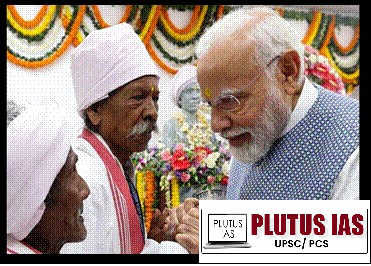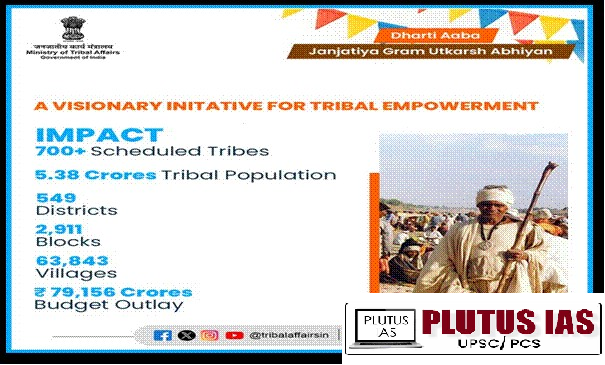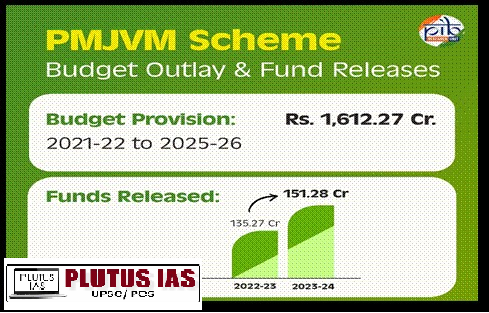16 Nov Empowering Tribal Society: Initiatives for Socio-Economic Development
SYLLABUS MAPPING:
GS-3-social issue-Empowering Tribal Society: Initiatives for Socio-Economic Development
FOR PRELIMS:
What is the primary objective of the Pradhan Mantri Janjatiya Vikas Mission (PMJVM) and its benefits?
FOR MAINS:
The socio-economic development of tribal communities in India is often hindered by their marginalization in mainstream development policies. Discuss the role of the Panchayats (Extension to Scheduled Areas) Act (PESA) in empowering tribal self-governance and ensuring their development.
Why in the news?
To honor the legacy and heritage of tribal communities, India has been observing Janjatiya Diwas on November 15th, the birth anniversary of Bhagwan Birsa Munda, a revered leader among tribal groups. Birsa Munda is remembered for his courageous fight against the exploitative British colonial rule and his leadership in the freedom struggle. Since 2021, Janjatiya Gaurav Divas has been celebrated across the country to pay tribute to the sacrifices of tribal freedom fighters. This year, marking the 150th birth anniversary of Birsa Munda, the Prime Minister will unveil a special commemorative coin and postal stamp. Additionally, development projects worth over Rs 6,640 crore will be launched to improve the socio-economic conditions of tribal communities, especially in rural and remote areas.

Introduction
India’s Scheduled Tribe (ST) population, comprising 10.42 million people (8.6% of the total population) across over 705 distinct groups, often resides in remote areas. To uplift these communities, the government has introduced various welfare schemes aimed at socio-economic empowerment, sustainable development, and the preservation of their rich cultural heritage. These initiatives are designed to improve living standards, promote education, and ensure inclusive growth for tribal populations.
Scheduled Tribe (ST) population:
1. Tribal Population: 104.28 million (approximately 8.6% of the total Indian population).
2. Tribal Groups: Over 705 distinct tribes are recognized across India.
3. Geographic Distribution: Tribes are predominantly found in remote, rural, and forested regions, often in states like Madhya Pradesh, Odisha, Jharkhand, Chhattisgarh, Gujarat, Maharashtra, Rajasthan, and the North-Eastern states.
Constitutional Provisions for Scheduled Tribes (STs) in India:
The Constitution of India contains various provisions to protect and promote the rights of Scheduled Tribes (STs), ensuring their social, educational, cultural, and political upliftment. While the term ‘tribe’ is not explicitly defined in the Constitution, the category of Scheduled Tribes (STs) is recognized through the following key provisions:
1. Article 342: Definition and Notification of Scheduled Tribes:
Article 342 empowers the President of India to specify, through a public notification, the tribes or tribal communities or parts of tribes that shall be recognized as Scheduled Tribes for the purposes of the Constitution.
2. Fifth Schedule: Tribal Areas and Advisory Council
The Fifth Schedule provides for the establishment of a Tribes’ Advisory Council in each state that has Scheduled Areas. This Council advises the state government on matters related to the welfare and development of Scheduled Tribes.
3. Educational & Cultural Safeguards
Article 15(4): Provides special provisions for the advancement of backward classes, including Scheduled Tribes.
Article 29: Protects the cultural and educational rights of minorities, including STs, allowing them to conserve their distinct language, script, and culture.
Article 46: The State is obligated to promote the educational and economic interests of the weaker sections, particularly Scheduled Castes (SCs) and Scheduled Tribes (STs), and protect them from social injustice and exploitation.
Article 350: Grants the right to conserve a distinct language, script, or culture, which applies to tribal communities.
4. Political Safeguards
Article 330: Provides for the reservation of seats for Scheduled Tribes in the Lok Sabha (House of the People).
Article 332: Ensures the reservation of seats for Scheduled Tribes in the State Legislative Assemblies.
Article 243: Ensures the reservation of seats for Scheduled Tribes in Panchayats (local bodies), enabling political participation at the grassroots level.
5. Administrative Safeguard
Article 275: Provides for special funds from the Union Government to the States for the welfare and administration of Scheduled Tribes, ensuring better governance and resource allocation.
Additional Provisions – SC, ST (Prevention of Atrocities) Act
1. Scheduled Castes and Scheduled Tribes (Prevention of Atrocities) Act, 1989:
This Act aims to prevent atrocities and discrimination against SCs and STs. It punishes acts of atrocity, exploitation, or discrimination committed against members of these communities.
It ensures that offenders committing such crimes are prosecuted and punished under special provisions.
The Act also provides for the establishment of Special Courts to try cases related to atrocities against SCs and STs.
2. Scheduled Castes and Scheduled Tribes (Prevention of Atrocities) Amendment Act, 2015:
The 2015 Amendment further strengthened the provisions, ensuring quicker justice and harsher penalties for crimes committed against SC/ST individuals.
It also makes provisions for economic support, rehabilitation, and restoration of the social status of victims of atrocities.
Key Tribal Development Schemes:
1. Dharti Aaba Janjatiya Gram Utkarsh Abhiyan: Launched by Prime Minister Narendra Modi on October 2, 2024, in Hazaribag , Jharkhand, this program has an outlay of over ₹79,156 crore. It aims to bridge critical gaps in social infrastructure, health, education, and livelihood development across 63,843 tribal villages. The goal is to improve the quality of life for tribal communities and enhance their socio-economic conditions.

2. Pradhan Mantri Janjati Adivasi Nyaya Maha Abhiyan (PM-JANMAN): On November 15, 2023, during Janjatiya Gaurav Divas in Khunti, Jharkhand, the PM-JANMAN was launched to uplift Particularly Vulnerable Tribal Groups (PVTGs). The scheme focuses on improving housing, clean drinking water, education, healthcare, road and telecom connectivity, electrification, and sustainable livelihoods for these communities.

3. Pradhan Mantri Adi Adarsh Gram Yojana (PMAAGY): Originally launched in 1977-78 as the Special Central Assistance to Tribal Sub-Scheme (SCA to TSS), it was revamped in 2021-22 as the Pradhan Mantri Adi Adarsh Gram Yojana (PMAAGY). This scheme focuses on providing basic infrastructure in tribal-dominated villages. 36,428 villages with at least 50% tribal population, including those in Aspirational Districts, have been identified for development under this initiative.
4. Eklavya Model Residential Schools (EMRS): Launched in 2018-19, the Eklavya Model Residential Schools (EMRS) aim to provide quality education to tribal students, focusing on academic, cultural, and skill development. On October 2, 2024, 40 EMRS were inaugurated, and the foundation for 25 more was laid. The scheme has an investment of over ₹2,800 crore, and 728 EMRS have been approved across the country to date.
5. Pradhan Mantri Janjatiya Vikas Mission (PMJVM): PMJVM focuses on promoting tribal entrepreneurship and the “Vocal for Local by Tribal” initiative. It supports tribal communities in making better use of Minor Forest Products (MFPs) and non-MFPs to create local product-based businesses, empowering tribal communities economically and socially.

6. Pradhan Mantri Vanbandhu Kalyan Yojana (PMVKY): Launched on October 28, 2014, PMVKY is a transformative initiative designed to address the unique challenges faced by India’s tribal communities. This program aims to empower tribes, enhance their socio-economic conditions, and preserve their cultural heritage by focusing on development in health, education, infrastructure, and livelihood.
Financial Support and Self-Employment Schemes for Tribal Communities:
To empower tribal communities economically, the government has launched several financial support schemes focused on income generation, self-employment, and economic development. These initiatives aim to provide financial resources and opportunities for tribal individuals and groups to start and sustain their businesses.
1. National Scheduled Tribes Finance and Development Corporation (NSTFDC):
Term Loan Scheme: Offers loans for projects up to ₹50 lakh per unit to support income-generating activities.
Adivasi Mahila Sashaktikaran Yojana (AMSY): Aimed at empowering tribal women, this scheme provides loans up to ₹2 lakh per unit for women’s income-generating activities.
Micro Credit Scheme for Self-Help Groups (SHGs): Provides loans of up to ₹5 lakh per Self-Help Group and ₹50,000 per member to promote group-based economic activities.
Adivasi Shiksha Rin Yojana (Education Loan): Offers loans of up to ₹10 lakh for Scheduled Tribe students pursuing professional or technical education in India.
Health Initiatives for Tribal Communities:
1. Sickle Cell Anaemia Elimination Mission (Launched on July 1, 2023): Aiming to eliminate Sickle Cell Disease (SCD), this mission focuses on awareness campaigns, universal screening, and providing affordable care, particularly for tribal communities in Central, Western, and Southern India.
2. Mission Indradhanush: This initiative focuses on providing full immunization to children up to 2 years of age and pregnant women, with a special emphasis on tribal areas. The mission has also expanded to provide free COVID-19 vaccines to tribal populations.
3. Nikshay Mitra Initiative: This program supports tuberculosis (TB) patients, many of whom are from tribal areas. It provides diagnostic, nutritional, and vocational support to improve TB treatment outcomes and promote better health.
Research and Cultural Preservation Initiatives:
In addition to welfare programs, the government has implemented initiatives focusing on the preservation and promotion of tribal cultures, traditions, and languages, as well as research to understand socio-economic challenges better.
1. Particularly Vulnerable Tribal Groups (PVTGs): Development ProgramThe Ministry of Tribal Affairs has been implementing this scheme to promote the socio-economic development and welfare of the most vulnerable tribal communities. Initially, 75 PVTGs were identified for focused development. From 2023-24, this program has been integrated into the Pradhan Mantri Janjati Adivasi Nyaya Maha Abhiyan (PM-JANMAN) initiative.
2. Support to Tribal Research Institutes (TRIs): TRIs play a crucial role in documenting and preserving tribal cultures, languages, and medicinal practices. The Support to TRIs scheme promotes research and organizes cultural festivals and exchange programs, helping raise awareness about tribal traditions and promoting their welfare.
3. Tribal Research Information, Education, Communication and Events (TRI-ECE): The TRI-ECE scheme supports public awareness initiatives, including advertisements, exhibitions, and cultural events. It also organizes Republic Day celebrations, festivals, and other events aimed at promoting tribal culture. The funding for this scheme has increased from ₹15 crore in 2022-23 to ₹25 crore in 2023-24, with specific allocations for advertising, publicity, and general charges.
Challenges in Ensuring Tribal Growth and Inclusion:
1. Land Alienation: Tribal communities face loss of land due to encroachment, displacement, and land acquisitions, threatening their livelihood and traditional practices.
2. Inadequate Healthcare: Many tribal areas lack sufficient healthcare infrastructure, resulting in higher rates of malnutrition, disease, and mortality.
3. Social Discrimination: Tribals often experience discrimination, exploitation, and marginalization, despite legal protections, leading to social exclusion and human rights violations.
4. Limited Economic Opportunities: Despite various welfare schemes, tribal communities often lack access to sustainable employment and income-generating opportunities, resulting in continued poverty.
5. Education Gaps: High dropout rates and lack of quality education in tribal regions limit future opportunities, keeping many in a cycle of underdevelopment.
6. Infrastructure Deficiencies: Poor road connectivity, inadequate electricity, and lack of clean drinking water and sanitation in tribal areas hinder overall development and access to basic services.
Conclusion:
The government’s multi-faceted approach to tribal welfare focuses on empowerment, self-sufficiency, education, health, and cultural preservation. Through schemes such as financial support for self-employment, education loans, health initiatives like the Sickle Cell Anaemia Mission, and research programs for cultural preservation, tribal communities are being uplifted and integrated into the broader development framework of the nation.
These initiatives align with the “Sabka Saath, Sabka Vikas” vision, ensuring that tribal communities are not left behind in India’s progress. By fostering inclusive development, these programs enable tribal communities to preserve their cultural identity while benefiting from improved socio-economic conditions and opportunities for growth.
Download Plutus IAS Current Affairs ENG MED 16th Nov 2024 pdf
Prelims Question:
(250 words, 15 marks)




No Comments